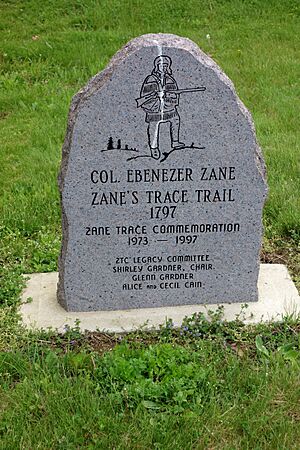Ebenezer Zane facts for kids
Quick facts for kids
Ebenezer Zane
|
|
|---|---|
| Member of the Virginia House of Delegates from Ohio County | |
| In office December 2, 1799 – 1800 Serving with Benjamin Biggs
|
|
| Preceded by | Archibald Woods |
| Succeeded by | William McKinley |
| In office May 5, 1783 – October 16, 1785 Serving with David Shepherd
|
|
| Preceded by | Andrew Robison |
| Succeeded by | David Bradford |
| In office May 1, 1780 – May 7, 1781 Serving with Samuel McCullouch
|
|
| Preceded by | Andrew Robison |
| Succeeded by | n/a |
| Personal details | |
| Born | October 7, 1747 Moorefield, Virginia, British America |
| Died | November 19, 1811 (aged 64) Wheeling, Ohio County, Virginia, U.S. |

Ebenezer Zane (born October 7, 1747 – died November 19, 1811) was an important American pioneer. He was also a soldier, politician, and built a famous road. Born in Virginia, he helped start the city of Wheeling, West Virginia. This city is located on the Ohio River. He also created an important early road called Zane's Trace. This road went through the Ohio Country to what is now Maysville, Kentucky.
Contents
Zane's Family and Early Life
Ebenezer Zane was one of six children. His parents were William Andrew Zane and Nancy Ann Nolan. They moved from New Jersey to Virginia. Ebenezer had four brothers: Silas, Andrew, Jonathan, and Isaac. He also had one sister, Elizabeth, often called "Betty."
One of his brothers, Isaac, was captured by Native Americans. He lived with them for over ten years. He married a Native American woman. A town in Ohio, Zanesfield, Ohio, was later named in his honor.
Ebenezer Zane married Elizabeth McColloch. They had eleven children together. Many of their children died young. Their daughter Catherine married Absalom Martin. He helped found Martins Ferry, Ohio. Another daughter, Sarah, married John McIntire. John helped build Zane's Trace. He also founded Zanesville, Ohio, which was named after him. Their son Noah later served in the Virginia government. Ebenezer Zane was also an ancestor of the famous author Zane Grey.
From Soldier to Politician
In 1763, a treaty tried to stop settlers from moving west. But Ebenezer Zane and his brothers moved anyway. They traveled across the Appalachian Mountains to the Ohio River. They started clearing land near Wheeling Creek. In 1769, they helped build Fort Henry there. This fort protected settlers from Native American attacks.
Ebenezer Zane became a colonel in the Virginia militia. In 1776, he renamed the fort after Patrick Henry. Patrick Henry was a leader who supported western Virginians. During the American Revolutionary War, Fort Henry was attacked several times. Ebenezer's brother, Silas, and his sister, Betty, helped defend the fort. Betty Zane became famous for her bravery. She ran out of the fort to get gunpowder during a siege.
Ebenezer Zane also became active in politics. He represented northwestern Virginia in the government. Voters in Ohio County elected him to the Virginia House of Delegates many times. In 1788, he voted to approve the United States Constitution.
Building Zane's Trace

After the Revolutionary War, Zane wanted to build a road. In 1796, the United States Congress gave him permission. They also gave him money for the project. He worked with his brother Jonathan and his son-in-law John McIntire. A Native American guide named Tomepomehala also helped them.
As payment, Congress gave Zane three large areas of land. These areas were where the road crossed major rivers. His helpers received the land that became Zanesville, Ohio. Other land became Lancaster, Ohio and Chillicothe, Ohio.
When Zane's Trace was finished, it crossed what is now Ohio. It went from Wheeling, Virginia, to Maysville, Kentucky. At first, it was a simple path. People could only travel on it by foot or horseback. Wagons could not use it. Later, Ohio improved the road. It was the only major road in Ohio until the War of 1812.
Death and Legacy
Ebenezer Zane died in November 1811. He was buried in Martins Ferry, Ohio. In his will, he divided his land among his family. His sons Noah and Daniel received land in and near Wheeling. His son Samuel received land in other parts of Virginia and Ohio. His daughters Rebecca and Esther also received money from land sales.
Ebenezer Zane's wife, Elizabeth, later freed the enslaved people she owned. She also left the ferry businesses to her sons Noah and Daniel. The city of Zanesville, Ohio, was named in Ebenezer Zane's honor.

